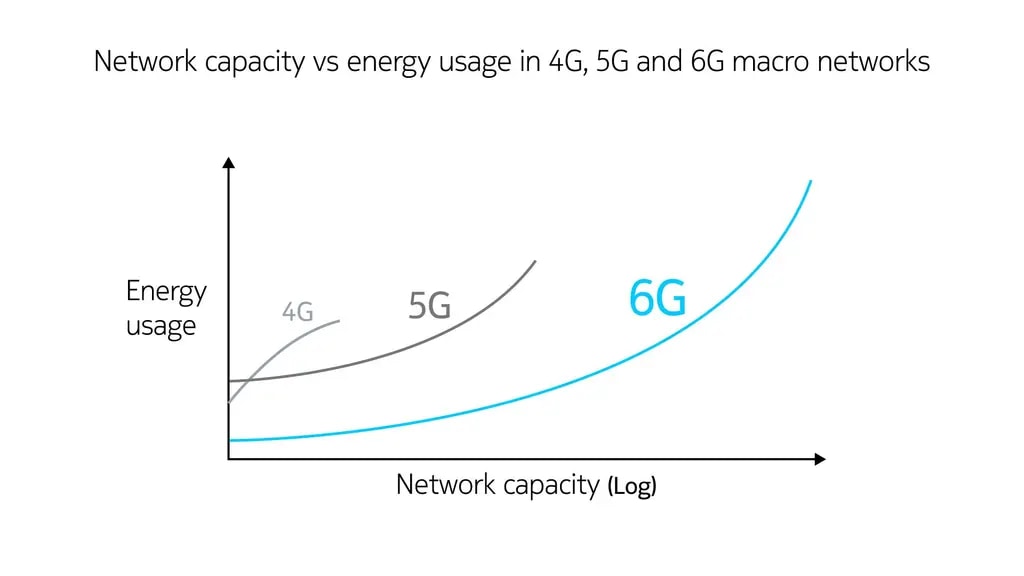In the 6G era, we won’t need to sacrifice sustainability for the sake of performance

The issue of sustainability drives an increasing number of choices people make in their daily lives. It determines the food we eat, the modes of transport we take and even where we live. In the foreseeable future, we can add how we communicate to the list of sustainable choices we make.
In the 6G era, sustainability will be one of the primary determining factors in how networks are built. 5G has made substantial gains in energy efficiency, which 5G-Advanced is further improving upon. But historically the main focus of the industry has always been on optimizing performance.
As we move to 6G, that focus will shift. Performance will still be a priority, with demand for capacity expected to grow 10 times over what we see on 5G networks. But the environmental impact of our communications will be equally important. The challenge we face is delivering tremendous amounts of new capacity while simultaneously lowering the network’s overall energy consumption. In short, we need to maximize our communications handprint, while minimizing our environmental footprint. To accomplish this, we need to rethink the design of every component of the 6G network.
Aggressive energy targets
6G research has only just begun and no standard benchmarks have yet been established for the technology, but early discussions in the industry point to sustainability becoming a major component of the next generation of networking. We believe that the target for 6G should be cutting the average power consumption of 6G networks in half compared to 5G, while still supporting peak capacities 10 times higher than today’s 5G networks.
The chart below illustrates the proposed key differences in energy efficiency between the two generations under all load conditions:

Starting at the left end of the chart, we envision a 6G radio access network (RAN) that consumes practically no electricity when no users are connected. Moving toward the right in the chart, we find that at every capacity level achieved by 5G, the 6G network would support the same number of users or overall capacity at much lower power, making it vastly more efficient in watts per gigabit.
To reach these energy-efficiency gains will require new technologies in every aspect of the RAN from the power amplifier and antenna design to the processing architecture, algorithms and overall network topology. Networks are not monolithic entities in the way they consume power. As demands on the network increase, electricity demands shift to different elements, meaning we need to find holistic solutions to achieve our aggressive energy targets. A new Nokia Bell Labs white paper details the specific technologies we are researching that will minimize energy consumption as network conditions change. In general, that research falls into three categories.
The first category are technologies that lower the baseline power requirements of the network at all times, regardless of whether the network is lightly or heavily loaded with users. This research includes new efficiency improvements to the power amplifier, which is the most power-intensive element of the RAN. We are also exploring new system-on-a-chip (SoC) designs that will use compute-in-memory techniques, which will eliminate energy waste in computation. Finally, we’re examining new dense network architectures that could prove much more power efficient than macro-cellular architectures, while still maintaining the same coverage and capacity.
The next category of technologies focuses on low-to-mid-load conditions in the network. When only a few users are consuming few resources, we want to match energy consumption by “powering down” the network. For these situations, we are exploring new AI-assisted power-management techniques that will rapidly turn off 6G radios and digital processing elements during periods of inactivity, and then rapidly turn them back on when traffic increases. While sleep modes have been known for a decade, innovations in 6G will allow for much faster wake-up times with much lower power consumption in the sleep state, hence enabling a more efficient dynamic matching of energy consumption with traffic load. We are also researching what is essentially an “off switch” for entire cells, which will turn off specific frequencies in the network during lower-traffic periods, reducing the number of cells operating.
The final category targets mid-to-high-volume use of the 6G network. At this level, we aren’t focused as much on minimizing relative power consumption, but rather maximizing the efficiency of the network to deliver enormous amounts of capacity. We hope to accomplish this through massive MIMO muting, which will create smaller transmit arrays, and new scalable computing architectures in the radio unit, which will power down certain functions that are primarily utilized during low-load conditions. Finally, we’re exploring centralizing a portion of 6G RAN processing in the cloud, which will not only achieve energy savings through multiplexing but also from more efficient cooling.
Green cells
While 6G will usher in new opportunities for energy efficiency, there’s far more to sustainability than tamping down power consumption. To create truly sustainable networks in the 6G era, we need to look at the environmental impacts of every aspect of 6G systems.
Nokia Bell Labs is researching multiple sustainable technologies that could make the cell site of the future far greener. We’re investigating whether greater numbers of base stations can be self-powering through renewable energy sources such as solar panels. We’re researching ways to redirect heat from the RAN’s own cooling systems into electricity generation that can power the network. We’re even discovering ways to capture carbon emissions at the cell site, further offsetting the network’s carbon footprint.
While the first 6G networks won’t be commercially available until around 2030, it’s critical we begin making decisions for the future now. Today, the telecom industry consumes around 1% of all global energy, but if nothing were to change, the expected increase in data traffic and infrastructure could double or triple that figure by the end of the decade. That’s why Nokia has set the ambitious target of cutting its global greenhouse gas emissions in half by 2030, joining a global effort to limit global temperature rise to 1.5°C.
Building more energy-efficient and sustainable networks has long been a goal of the mobile industry, but that goal has usually taken a backseat to building high-performance networks. In the 6G era, Nokia can do both.

